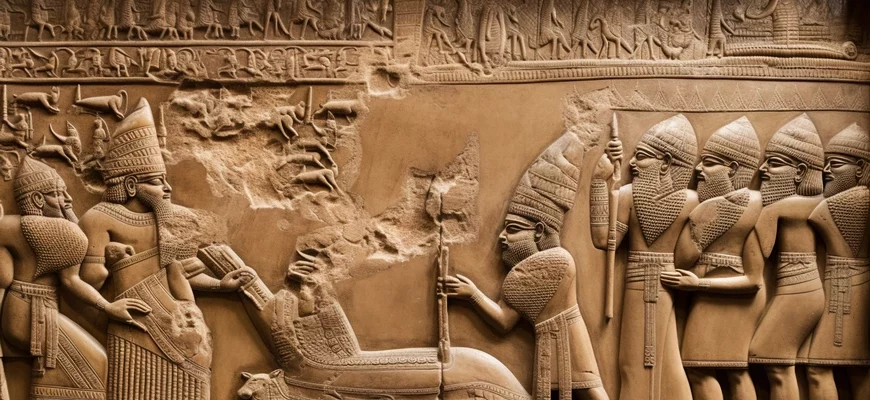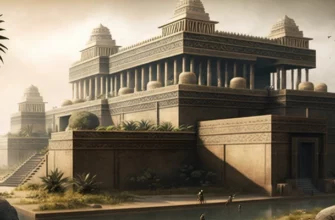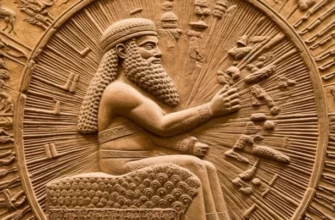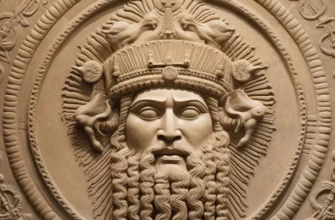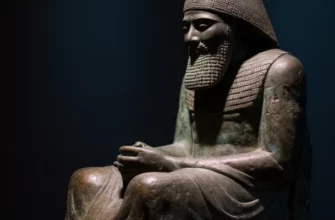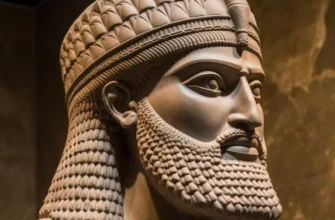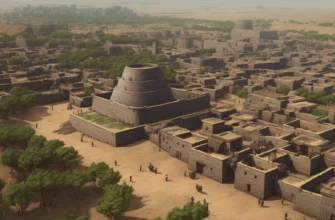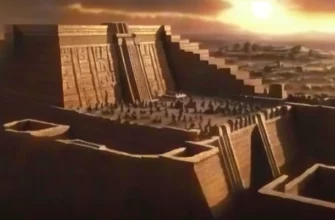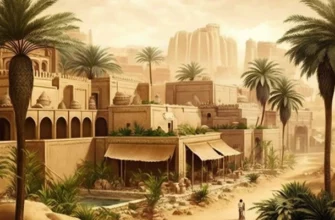Mesopotamia was the cradle of civilization, where religion played an important role in people’s lives. The Old Babylonian period was marked by the worship of many gods. The Hammurabi period is known for its Code and the greater role of women in religion. The Assyrian period was accompanied by the development of armed forces and holiday palaces for the gods. The Neo-Babylonian period was associated with the growth of astrology’s influence. The Persian period was accompanied by changes in the religious system and the influence of star worship. Religion in Mesopotamia had a great influence on culture and science, and its significance remains important for world history.
- The Old Babylonian period (9th-18th centuries BC)
- Religious system and gods
- The Hammurabi period (18th century BC)
- The Code of Hammurabi and religion
- Assyrian period (9th-7th centuries BC)
- Gods and religious system
- The Neo-Babylonian period (7th-6th centuries BC)
- Period of Persian influence (6th-4th centuries BC)
- Changes in the religious system
- The role of religion in Mesopotamian society
- Conclusions
The Old Babylonian period (9th-18th centuries BC)
The Old Babylonian period (9th-18th centuries BC) refers to the early history of Mesopotamia, when the first state formations emerged in the region. During this period, religious practices played an important role in the lives of the population, who believed in polytheism. The main gods worshipped during this period included Marduk, Ishtar, Anu, and Enlil. Religious rituals and priesthood were also very important, which was reflected in the development of clergy and temples. In the Old Babylonian period, religion played an important role in society, regulating people’s behavior and relationships between them.
Religious system and gods
The Old Babylonian period, which lasted from the 9th to the 18th century BC, is known for its religious system and culture. The religious system of the ancient Babylonians was polytheistic, meaning they believed in many gods.
One of the most important gods in ancient Babylonian religion was Marduk. He was the god of the sky and earth, war, and wisdom. In the pantheon of ancient Babylonian gods, Marduk was recognized as the chief god, which gave him importance and authority in the ancient Babylonian world.
Another important god was Ishtar, the goddess of love, war, and fertility. Her cult was especially popular among women, who prayed to her for the protection and health of their children.
The patron god of the city of Babylon was Marduk, who represented a great power that protected the city from enemy attacks and bad weather. Other important gods were Ashur, the god of war; Nabu, the god of writing and wisdom; and Nanna, the god of the moon.
Ancient Babylonian religion also had underground gods associated with the underworld. These were the gods of the underworld, Ereshkigal and Nergal.
The ancient Babylonian period was known for its religious tolerance, and although Marduk was recognized as the chief god, other gods were also respected and could be worshipped according to each person’s choice.
The Hammurabi period (18th century BC)
The Hammurabi period spanned from around 1792 to 1750 BC and was characterized by the significant development of the Babylonian Empire, which was one of the largest and most powerful states of its time.
During Hammurabi, the Babylonian king, a legal system known as the “Code of Hammurabi” was created. It was a set of laws and rules that formed the basis of the legal system and were adopted to ensure justice and order in the empire. The Code of Hammurabi contained about 282 laws that established rules for various areas of life, such as family law, criminal law, and trade.
Hammurabi also made significant developments in urban planning and ensuring the well-being of the Babylonian population. He founded a new city, which he named after himself – Hammurabi, which became the new center of the empire. New canals and roads were also built, providing connections between different regions of the empire and promoting trade and economic development.
In the religious sphere, Hammurabi supported the cult of Marduk, who was the chief god of the Babylonian Empire. He provided significant support for the temples of Marduk and other gods, which contributed to the development of religion and culture in general.
The Hammurabi period was a time of significant development for Babylonian civilization, which had a significant impact on the further development of the East. An important aspect of the Hammurabi period was also the expansion of the empire’s territory through the conquest of neighboring territories. Hammurabi managed to gain control over Mesopotamia and many other regions, which ensured a significant increase in the territory of the empire.
This period also saw significant development in art and literature. Babylonian literature flourished, and epic poems recounting the mythology and history of this era have survived to this day. Architecture, sculpture, and stained glass art also developed significantly.
During the Hammurabi period, the power of the king, who was the heir to the previous dynasty, was significantly strengthened. Hammurabi became the first Babylonian king who managed to completely centralize power and ensure the unity of the empire. He managed to preserve the integrity of the state and establish a system of government that ensured the effective functioning of the empire.
As a result, the Hammurabi period was a time of significant development of Babylonian civilization and its culture, which had a significant impact on the further development of the East and world history as a whole.
The Code of Hammurabi and religion
The Code of Hammurabi is a set of laws written in the Akkadian language in the 18th century BC during the reign of Hammurabi, king of Babylon. This code is one of the most important documents of that time that has survived to this day and gives us an idea of the legal system and social structure of the Babylonian Empire.
The code contains more than 280 laws governing various aspects of Babylonian life, including family law, property relations, criminal law, and more. The most famous laws of the Code of Hammurabi are those relating to punishment for crimes, including theft, physical abuse, and murder. These laws often provide for severe punishments, including the death penalty and amputation of limbs.
Religion during the period of Hammurabi was a very important aspect of Babylonian life. They believed in many gods who represented different aspects of the world and nature. The main gods of Babylonia were Marduk, the god of the sky and Earth, and Ishtar, the goddess of love and war. Religious ceremonies and rituals were closely linked to politics and power and were important for ensuring the legitimacy of royal authority.
In general, religion during this period was inextricably linked to the empire and its power, and it was believed that the gods were endowed with power and wisdom, which gave kings the right to rule over the land and its people. Religious cultures and rituals were closely linked to the social structure, and priests played an important role in religion, exerting great influence on politics and society.
Divine prophets and magicians, who had the ability to predict the future and interact with the gods, were also an important element of religion during this period. Hammurabi and his successors believed in performing religious rituals to ensure the well-being of the empire and its people.
Although there were many gods during this period, Marduk was the chief deity, worshipped as both the god of war and the god of wisdom. Marduk’s name was associated with that of the military leader and emperor, reflecting his great power and authority.
In particular, the Code of Hammurabi contains instructions on how to take measures to support and protect the gods, as well as requirements for priests and magicians. This was an essential part of life in Babylonia, which considered religion not only a system of beliefs, but also a source of power and authority.
Assyrian period (9th-7th centuries BC)
The Assyrian period (9th-7th centuries BC) was the era of the Assyrian Empire, which was located in the northwestern part of Mesopotamia. During this period, Assyria became one of the most powerful empires of its time, conquering territories from Syria to Egypt. During this period, Assyria was known for its military power, as well as its developed culture and religion.
Religion in Assyria was polytheistic, with many gods and goddesses representing different aspects of life. The most important god was Ashur, the god of war and patron of Assyria, who was depicted with an axe in his hand. Most gods and goddesses were associated with natural phenomena, such as Adad, the god of thunder and rain, and Ishtar, the goddess of love and fertility.
Religion was deeply embedded in the social order of Assyria, where priests had a significant influence on politics and culture. The construction of sacred temples, which were the center of religious life, played an important role. Religious rituals were performed in these temples, and sacred objects and documents were kept there.
Assyrian culture was also linked to religion, which was reflected in the magnificent palace buildings and sculptures depicting gods and heroes. During this period, Assyria produced a rich body of literature containing information about religion, history, laws, and other aspects of life in the empire.
Artistic and architectural heritage also played a significant role in the Assyrian Empire. During this period, many magnificent palaces were built, decorated with murals and reliefs depicting military campaigns and religious rituals. The most famous of these is the palace of Ashurbanipal in Nineveh.
All these achievements of the Assyrian Empire, including religion and culture, were made possible by a developed system of government and technological progress. Assyria invented new methods of iron processing, construction, and water storage, which made it possible to maintain a developed economy and provide for a large army.
Overall, the Assyrian period was very significant for the history of Mesopotamia and the world as a whole. The religion and culture of the Assyrian Empire were quite diverse, but they played an important role in the formation of the empire and its further development.
Gods and religious system
The religious system of the Assyrian Empire reflected a complex syncretic mixture of different religious beliefs and practices. The main deity was Ashur, who was recognized as the supreme deity, with other gods and goddesses subordinate to him. Ashshur was associated with military achievements and was considered the patron of the empire. Many other deities were also present in the Assyrian religion, including Adad (god of thunder and rain), Ishtar (goddess of love and war), Shamash (god of the sun and justice), and others.
The Assyrian Empire had a complex system of cults and religious practices. This included various rituals such as sacrifices, prayers, religious festivals, and various rituals. There were also special prophets and priests who played an important role in religious practices and beliefs.
One important aspect of Assyrian religion was the belief in spirits and demons that could interfere with human lives and cause harm. This led to the development of beliefs in magic and witchcraft, which played an important role in religious practices and everyday life.
Overall, the religious system of Assyria was complex and diverse, incorporating elements of the Mesopotamian pantheon and the religions of the lands adjacent to Assyria. Religion played an important role in the life of the empire, supporting its cultural and social structure, contributing to military expansion, and supporting the expansion of trade relations with other peoples.
Sacred books played a prominent role in Assyrian religious beliefs, containing rules of conduct, magic formulas, and instructions for sacrificers and priests. One of the most famous sacred books was the “Ashshuritum,” dedicated to the cult of Ashur, which was translated from Assyrian into Akkadian.
Assyrian religion also had several elements that were of cosmic significance. For example, each of the five planets of the solar system (Mercury, Venus, Mars, Jupiter, and Saturn) was associated with its own god. Belief in the zodiac was also important in Assyrian religion.
In general, Assyrian religion had a great influence on the development of science, art, and culture of that time. Its practices and beliefs were often mentioned in other religions, which illustrated the importance of Assyria as a cultural force of that time.
The Neo-Babylonian period (7th-6th centuries BC)
The Neo-Babylonian period covers the time from the 7th to the 6th century BC and includes the period under the rule of the Babylonian Empire after the Chaldean period. During this period, the Neo-Babylonian Empire became one of the most powerful states of the Ancient East, known for its military might, magnificent buildings, and developed culture.
In the religious system of the Neo-Babylonian period, several major deities can be identified that were of particular importance to believers. One of the most revered gods was Marduk, the chief god of the Neo-Babylonian pantheon. His cult was also associated with famous ancient myths about the creation of the world and the victory over chaos.
Other important gods were Ishtar, the goddess of love and war, Nabu, the god of wisdom and writing, and Shamash, the god of the sun and justice. These gods had a great influence on the religious life of New Babylon and were revered not only within the state but also beyond its borders.
During this period, many new religious rituals and practices were developed. For example, the practice of prayer was developed, and new rites and rituals for worshipping deities were introduced. In addition, new forms of art appeared during this period, such as high reliefs depicting religious scenes and deities.
In general, the religion of New Babylon had a great influence on the culture and society of the time. Religious beliefs and practices were closely linked to the political and social practices of the state. For example, the kings of New Babylon were considered earthly representatives of deities and played an important role in rituals and ceremonies. In addition, many of the laws and rules in New Babylon had a religious basis.
One of the most famous religious buildings of this period is the high tower of Etemenanki, which was dedicated to Marduk. This building had great symbolic and religious significance for the inhabitants of Babylon.
In addition, astronomical knowledge was widespread in New Babylon, which was also related to religion. Babylonian astronomers were the first to compile a star calendar, which allowed them to determine the time by the position of the stars, and also observed the movement of the planets to predict events related to the gods.
In general, the religious system of New Babylonia had a great influence on the culture and society of the Ancient East at that time. It played an important role in the formation of moral and ethical values, the development of science and art, and the formation of what we now call “civilization.”
Period of Persian influence (6th-4th centuries BC)
The period of Persian influence in the history of the Ancient East (6th-4th centuries BC) was associated with the formation of the Persian Empire and its influence on the culture, religion, and other aspects of life of the peoples who lived in the territory of modern Iran and neighboring regions.
In the Persian world, the religious system was multi-layered and complex. One of the central gods was Ahura Mazda, who was considered the god of good and light. There were also many other deities who played an important role in the Persian religion. For example, Mithra was the god of the sun and light, and Angra Mainyu was the god of evil and darkness.
One of the important aspects of Persian religion was astrology, which played an important role in the lives of Persian priests and rulers. With the help of astrology, they tried to predict the future and determine the best time to carry out various activities.
In addition to religion, art, especially medical science and architecture, developed in Persia. Persian art historians developed a complex system of geometric proportions that was used in the construction of buildings and monuments. The most famous examples of Persian architecture are the Shirvanshah Palace in Baku and Persepolis in modern Iran.
The period of Persian influence was also a time of intense trade and diplomatic relations between various states of the Ancient East.
Changes in the religious system
The period of Persian influence was marked by significant changes in the religious system of Mesopotamia. The Persians, who conquered Babylon, introduced their religion based on Zoroastrianism, which eventually mixed with local beliefs.
During the reign of the Persian king Cyrus the Great, the Jews were allowed to return to Jerusalem and rebuild their temple. The Jews returned with their religious views, beliefs, and shrines, which influenced the local religion.
During the period of Persian rule, various cult centers and shrines also developed, headed by priest-magi. The magi served as intermediaries between the deities and the people, performing various rituals and ceremonies.
During this period, new deities also appeared, such as Angra Mainyu, the goddess of nightmares and evil spirits, and Tirtaq, the god of health and medicine. New cult centers dedicated to these deities appeared.
However, many old deities continued to be revered during this period, including Marduk, the god of Babylon, who retained his leading position in the pantheon of deities.
The role of religion in Mesopotamian society
Religion in Mesopotamia played an important role in society, influencing all aspects of people’s lives, from politics and economics to everyday life and culture. Many of the religious beliefs and rituals were associated with the Euphrates and Tigris rivers, which provided fertile soil for agriculture, as well as with farming and cattle breeding.
There were many different deities in Mesopotamia, each associated with a particular aspect of life. For example, Marduk was the god of Babylon and symbolized dominion over other peoples, Ea was the god of water and wisdom, and Inanna was the goddess of love and war. The inhabitants of Mesopotamia believed that the gods influenced all aspects of their lives, so they turned to them for protection, blessings, and help in all areas of life.
Religion also played an important role in politics and governance. Power was linked to religion, as many rulers claimed to be deities or their messengers on earth. Each city had its own patron god who brought protection and victory to its community. There were also special shrines where sacred objects and images of deities were kept, which were considered a source of strength and power.
Religion also influenced art and culture. Many architectural and artistic masterpieces were dedicated to deities, and their symbols and images were found on a wide variety of objects, from seals
Religion had a profound influence on all areas of Mesopotamian life, including politics, economics, and culture. Gods and goddesses were considered protectors and patrons of cities, countries, families, and individuals. They were also responsible for natural phenomena such as rain, floods, droughts, and crop yields.
Conclusions
General characteristics of the development of religion in Mesopotamia:
Mesopotamia is considered the cradle of civilization, so religion in this country had a great influence on the development of religious thought in the world. The religious culture of Mesopotamia was formed more than 4,000 years ago and had a very complex hierarchy of deities. People divided the world into good and evil, and most deities were associated with certain natural phenomena. For example, there are deities associated with water, fire, earth, and other elements. Religious views were preserved in written form on clay tablets, which allowed them to be preserved for future generations.
The importance of Mesopotamian religion for world culture:
Mesopotamia ensured the development of civilization, and its religious culture was one of the most important components of this development. It influenced the religious culture of many peoples, including Jews and Christians, who mention Mesopotamia and its deities in their holy books. In addition, the religious views of Mesopotamia formed the basis for the development of philosophy, which gave impetus to the creation of many philosophical schools in ancient Greece. The influence of Mesopotamian religion is also noticeable in the modern world, as many symbols that we use in our lives originate from Mesopotamian religion. For example, the signs of the zodiac, the symbols of the Sun, Moon, snake, lion, eagle, and other animals and objects have their roots in Mesopotamian religion. In addition, Mesopotamian religious rites and traditions, such as the use of aromatic oils and other substances in religious ceremonies, have also left their mark on world culture.
